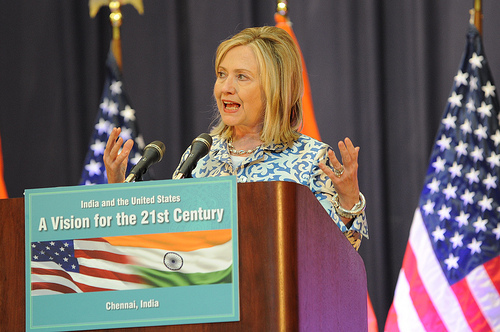
There is a conundrum at the heart of the Obama administration’s “pivot” toward Asia, at least as it relates to India. The US is eager to extricate itself from military conflicts in the Greater Middle East (Iraq and Afghanistan) so it can focus on a region where, as President Obama put it, “the action’s going to be.” Shoring up the US strategic posture in East Asia amid China’s ascendance will entail a deepening of geopolitical cooperation between Washington and New Delhi. But the quickening withdrawal from Afghanistan will increase bilateral frictions, pushing relations in the opposite direction.
The Pentagon’s just-released strategic guidance paper calls for “investing in a long-term strategic partnership with India to support its ability to serve as a regional economic anchor and provider of security in the broader Indian Ocean region.” Both Obama during his visit to India in November 2010 and Secretary of State Hillary Clinton during her trip last summer have called on New Delhi to play a more active strategic role in East Asia.
One of the unheralded stories of the past year is how India has begun to do just that. In defiance of Chinese warnings, New Delhi asserted its rights to hydrocarbon explorations off the coast of Vietnam, laying down its own marker in the South China Sea dispute. It has moved to enhance defense and economic ties with Japan, culminating in Prime Minister Noda Yoshihiko’s very productive visit to New Delhi last month. It also solidified security relations with Australia and Vietnam, and bolstered its influence in Myanmar vis-à-vis Beijing.
Washington and New Delhi hold regular consultations on East Asia policy, and a trilateral US-India-Japan security dialogue was launched last month. A revival of quadrilateral security cooperation among the US, Japan, India, and Australia that briefly flowered in 2006-07 also appears likely. The expansion of Chinese power and aspiration will undoubtedly push New Delhi to align closer with the US, though the process will neither be as smooth nor as speedy as many Americans would like.
Pushing in the other direction is the adverse effect on Indian security concerns caused by US disengagement from Afghanistan. Key differences are bound to emerge between the United States and India regarding the political endgame. Looking to the exits, Washington will not be overly concerned with the exact details of the makeup of Afghanistan or the viability of the government in Kabul. New Delhi, which has invested heavily in Hamid Karzai’s government, will be all too focused on how the strategic terrain is shifting to its detriment.
India has strong security interests in ensuring that any government in Kabul can be a bulwark against Pakistan as well as a gateway to trade and energy links in Central Asia. Both goals would be undermined if Islamabad achieved a central role in shaping a political settlement or if a Taliban-influenced regime were to come to power.
One wonders how committed Washington will be to the current regime’s survival or the protection of Indian equities in an accommodation with the Taliban. This is all the more so as US staying power is visibly waning. The security situation is likely to deteriorate as the military withdrawals that President Obama announced last summer take hold and as remaining US forces shift from direct combat operations to a back-stop role. A newly-minted National Intelligence Estimate reportedly is filled with pessimism about Afghanistan’s prospects.
Obama has promised to help Afghanistan “move from an economy shaped by war to one that can sustain a lasting peace.” Yet reports by the World Bank and the IMF underscore how formidable a challenge that will be. A recent report by Senate Foreign Relations Committee staffers concluded that US nation-building efforts have largely failed and warned that with Afghanistan so reliant upon foreign military and development spending it could slide into an economic depression as this funding decreases.
The transformation of US-Pakistan relations, from the past decade’s broad if dysfunctional security partnership to a more circumscribed, largely transactional arrangement will accelerate US disengagement. Islamabad will be even more stinting in deploying its influence with the Taliban and other militant groups to benefit US objectives in Afghanistan, while the higher transit fees likely to be charged on US military supplies moving through Pakistan will further dampen the Obama administration’s fortitude in Afghanistan.
As the US winds down its involvement, unpalatable circumstances await New Delhi’s policymakers. As a result, India will seek to move closer to Iran, whose interests in Afghanistan are roughly congruent. Both countries may even revive the cooperation that during the 1990s provided critical support to non-Pashtun militias battling the Taliban regime. (Already reports are surfacing that the old Northern Alliance may be reconstituting.) The US will grumble about cozying up with Iran, but the geopolitical logic of the US withdrawal leaves New Delhi little choice.
The interplay of two conflicting dynamics in US-India relations – growing strategic cooperation in East Asia and unfolding differences over the future of Afghanistan – will be a key factor to watch for in the years ahead.
David J Karl is president of the Asia Strategy Initiative, a political and economic consultancy. He was project director of the Task Force on Enhancing India-US Cooperation in the Global Innovation Economy, sponsored by the Federation of Indian Chambers of Commerce & Industry and the Pacific Council on International Policy.
This is a cross-post from CSIS

